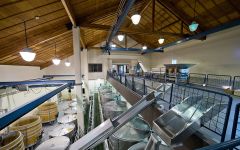WillaKenzie Estate Chardonnay 2018
-
Wilfred
Wong -
Robert
Parker



Product Details
Your Rating
Somm Note
Winemaker Notes
This Chardonnay is a classic expression of the Willamette Valley. Multi-layered notes of brioche, spicy minerality, and subtle oak, balanced by floral and citrus flavors.
Pair this wine alongside hard cheeses or shellfish.
Professional Ratings
-
Wilfred Wong of Wine.com
COMMENTARY: The 2018 WillaKenzie Estate Willamette Valley Chardonnay packs excellent and finely-tuned balanced and structure on the palate. TASTING NOTES: This wine serves up aromas and flavors of sandalwood, savory spices, dried apples, and earth. Enjoy it with roasted game birds. (Tasted: May 11, 2021, San Francisco, CA)
-
Robert Parker's Wine Advocate
The 2018 Chardonnay Willamette Valley has touches of candle smoke and flint over floral-laced white peaches. The palate is medium-bodied and rounded and slowly expands to gently honeyed fruits, finishing long and lifted.
Other Vintages
2019-
Robert
Parker
-
James
Suckling -
Wilfred
Wong -
Robert
Parker -
Wine
Enthusiast
-
Wine
Spectator







WillaKenzie Estate is located in Oregon's Willamette Valley on rolling hillsides in the Chehalem Mountains. The winery was named after the Willakenzie soil on which the vineyards are planted to convey the influence that the soil imparts on the wine's flavors and aromas. The vineyards are planted with grapes of the Pinot family, mostly new Dijon clones of Pinot Noir and Pinot Gris from Alsace. Pinot Noir and Pinot Gris are cool climate grapes, which are particularly well adapted to Oregon. As winemaker for WillaKenzie Estate, the acclaimed producer of single-vineyard Pinot Noir, Chardonnay and Pinot Gris, Erik Kramer leads all winemaking and cellar
operations. He has been working in Oregon’s Willamette Valley since 2004, where he has built a reputation for world-class wines of finesse and balance. A scientist by training, Erik worked as a hydrogeologist in the petrochemical industry before combining his passion for science and appreciation for fine wine into a career. He spent a few seasons in Washington as a harvest cellar worker before
pursuing a postgraduate diploma in viticulture & oenology at Lincoln University in New Zealand, where he graduated with honors. Kramer went on to craft wine in New Zealand before to moving to the Willamette Valley. Prior to joining WillaKenzie Estate, Erik crafted highly-regarded wines for Domaine Serene and Adelsheim Vineyard. He also holds a degree in geology from Florida State University, which he draws on today when considering the relationship between terroir and wine quality. When not at the winery, Erik enjoys spending time with his family at his wine country home in McMinnville

One of the most popular and versatile white wine grapes, Chardonnay offers a wide range of flavors and styles depending on where it is grown and how it is made. While it tends to flourish in most environments, Chardonnay from its Burgundian homeland produces some of the most remarkable and longest lived examples. California produces both oaky, buttery styles and leaner, European-inspired wines. Somm Secret—The Burgundian subregion of Chablis, while typically using older oak barrels, produces a bright style similar to the unoaked style. Anyone who doesn't like oaky Chardonnay would likely enjoy Chablis.

One of Pinot Noir's most successful New World outposts, the Willamette Valley is the largest and most important AVA in Oregon. With a continental climate moderated by the influence of the Pacific Ocean, it is perfect for cool-climate viticulture and the production of elegant wines.
Mountain ranges bordering three sides of the valley, particularly the Chehalem Mountains, provide the option for higher-elevation vineyard sites.
The valley's three prominent soil types (volcanic, sedimentary and silty, loess) make it unique and create significant differences in wine styles among its vineyards and sub-AVAs. The iron-rich, basalt-based, Jory volcanic soils found commonly in the Dundee Hills are rich in clay and hold water well; the chalky, sedimentary soils of Ribbon Ridge, Yamhill-Carlton and McMinnville encourage complex root systems as vines struggle to search for water and minerals. In the most southern stretch of the Willamette, the Eola-Amity Hills sub-AVA soils are mixed, shallow and well-drained. The Hills' close proximity to the Van Duzer Corridor (which became its own appellation as of 2019) also creates grapes with great concentration and firm acidity, leading to wines that perfectly express both power and grace.
Though Pinot noir enjoys the limelight here, Pinot Gris, Pinot Blanc and Chardonnay also thrive in the Willamette. Increasing curiosity has risen recently in the potential of others like Grüner Veltliner, Chenin Blanc and Gamay.
